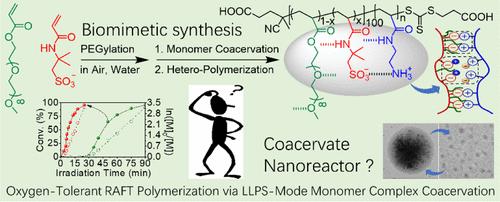聚簇纳米反应器:聚乙二醇侧链辅助区隔化导致耐氧聚合诱导静电自组装
IF 5.2
1区 化学
Q1 POLYMER SCIENCE
引用次数: 0
摘要
仿生合成是化学/材料科学的前沿课题。在此,我们证明了聚乙二醇(PEG)短侧链辅助单体络合物的凝聚和反应诱导的聚离子络合物区隔化导致耐氧聚合诱导的静电自组装(PIESA)。这是通过一锅合成聚乙二醇化阴离子聚电解质和阳离子单体的非均相迭代聚合在生态友好的环境下实现的,在空气中的水相光筏条件下。同时可逆全段参与三元络合物凝聚和库仑域间相互作用导致凝聚纳米反应器能够立即引发和快速可逆加成-破碎链转移反应。大约2纳米的单体复合纳米团簇作为驱动液-液相分离的基石。聚合利用纳米团簇作为构建单元,诱导了液滴成核-融合-裂变机制中的分层自组装以及聚乙二醇-聚离子络合物的区隔化,其机制类似于通过超分子聚合进行的液-液相分离。因此,实现了具有耐氧良好控制的快速反应的蛋白质样,单组分多室凝聚纳米反应器。这项工作为高效精确地合成越来越复杂的仿生凝聚态纳米器件提供了重要的意义。本文章由计算机程序翻译,如有差异,请以英文原文为准。

Coacervate Nanoreactors: PEG Side-Chain-Assisted Compartmentalization Leads to an Oxygen-Tolerant Polymerization-Induced Electrostatic Self-Assembly
Biomimetic synthesis represents a cutting-edge topic in chemistry/materials science. Herein, we demonstrate poly(ethylene glycol) (PEG) short side-chain-assisted monomer complex coacervation and reaction-induced polyion complex compartmentalization that lead to oxygen-tolerant polymerization-induced electrostatic self-assembly (PIESA). This is achieved by the one-pot synthesis of a PEGylated anionic polyelectrolyte and heterogeneous iterative polymerization of a cationic monomer under ecofriendly ambient, in-air aqueous photo-RAFT conditions. Simultaneous reversible all-segment-participating ternary complex coacervation and Coulombic interdomain interactions lead to coacervate nanoreactors that are capable of immediate initiation and fast reversible addition–fragmentation chain transfer reactions. Approximately 2 nm monomer complex nanoclusters act as building blocks to drive liquid–liquid phase separation. Polymerization induces hierarchical self-assembly in a droplet nucleation–fusion–fission mechanism together with PEG-crowded polyion complex compartmentalization, using nanoclusters as building blocks, mechanistically similar to liquid–liquid phase separation through supramolecular polymerization. Consequently, protein-like, one-component multicompartment coacervate nanoreactors with oxygen-tolerant well-controlled fast reactions are achieved. This work provides important implications for the efficient precise synthesis of biomimetic coacervate nanodevices of increasing complexity.
求助全文
通过发布文献求助,成功后即可免费获取论文全文。
去求助
来源期刊

Macromolecules
工程技术-高分子科学
CiteScore
9.30
自引率
16.40%
发文量
942
审稿时长
2 months
期刊介绍:
Macromolecules publishes original, fundamental, and impactful research on all aspects of polymer science. Topics of interest include synthesis (e.g., controlled polymerizations, polymerization catalysis, post polymerization modification, new monomer structures and polymer architectures, and polymerization mechanisms/kinetics analysis); phase behavior, thermodynamics, dynamic, and ordering/disordering phenomena (e.g., self-assembly, gelation, crystallization, solution/melt/solid-state characteristics); structure and properties (e.g., mechanical and rheological properties, surface/interfacial characteristics, electronic and transport properties); new state of the art characterization (e.g., spectroscopy, scattering, microscopy, rheology), simulation (e.g., Monte Carlo, molecular dynamics, multi-scale/coarse-grained modeling), and theoretical methods. Renewable/sustainable polymers, polymer networks, responsive polymers, electro-, magneto- and opto-active macromolecules, inorganic polymers, charge-transporting polymers (ion-containing, semiconducting, and conducting), nanostructured polymers, and polymer composites are also of interest. Typical papers published in Macromolecules showcase important and innovative concepts, experimental methods/observations, and theoretical/computational approaches that demonstrate a fundamental advance in the understanding of polymers.
 求助内容:
求助内容: 应助结果提醒方式:
应助结果提醒方式:


